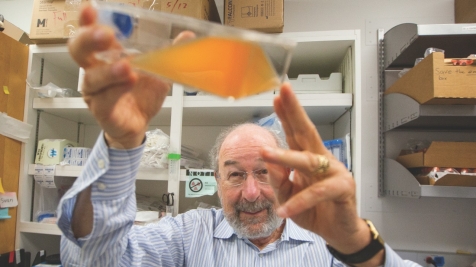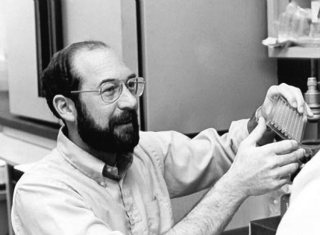
Ronald Levy, MD, today (top) and in 1981 (below)
Drug Synergy May Upend Cancer Treatment

Ronald Levy, MD, today (top) and in 1981 (below)
Drug Synergy May Upend Cancer Treatment
For decades, scientists have diligently been working toward new treatments for cancers by pursuing two lines of research: harnessing the power of the immune system to seek out and destroy tumors, or suffocating the tumors by blocking molecular pathways vital to the cancers’ survival. The best way to cure a cancer, though, may involve combining these two lines of attack, according to new research led by Stanford oncologist Ronald Levy, MD (professor, Oncology).
“Individually, these two kinds of therapies are already changing our cancer therapy paradigm,” says Levy. “But when combined, I think they’re really going to change things.”
The idea behind so-called cancer immunotherapies is that the human body already has built-in defenses that can abolish foreign entities; just as the immune system can fight off a cold virus, many researchers theorize that it can be coaxed to fight off a cancer. In the past few years, drugs based on this idea—which boost the activity of the immune system or trick it into attacking cancer cells—have begun to hit the market.
At the same time, targeted therapeutics are emerging that take advantage of the growing knowledge that scientists have gained about the genetics of cancers. When studies discover a particular mutation in a cancer cell’s DNA that allows it to thrive, researchers can develop drugs that reverse the effects of the mutation, stopping a cancer’s growth in its tracks.
Levy and his colleagues wondered what would happen when they combined drugs based on these two approaches. While immune therapies are only effective in some patients, they can lead to long-term remissions. Targeted therapies, on the other hand, usually cause short-term improvements, but work in more patients.
“We thought that putting the two together had the potential to get the best of both worlds,” says Levy.
So the team launched a preclinical study using anti-PD-L1 antibodies, an immunotherapy, together with the targeted drug ibrutinib.
Both of these drugs have been approved by the FDA and are actively being used in the clinic now. Together, the drugs were even more effective.
For decades, scientists have diligently been working toward new treatments for cancers by pursuing two lines of research: harnessing the power of the immune system to seek out and destroy tumors, or suffocating the tumors by blocking molecular pathways vital to the cancers’ survival. The best way to cure a cancer, though, may involve combining these two lines of attack, according to new research led by Stanford oncologist Ronald Levy, MD (professor, Oncology).
“Individually, these two kinds of therapies are already changing our cancer therapy paradigm,” says Levy. “But when combined, I think they’re really going to change things.”
The idea behind so-called cancer immunotherapies is that the human body already has built-in defenses that can abolish foreign entities; just as the immune system can fight off a cold virus, many researchers theorize that it can be coaxed to fight off a cancer. In the past few years, drugs based on this idea—which boost the activity of the immune system or trick it into attacking cancer cells—have begun to hit the market.
At the same time, targeted therapeutics are emerging that take advantage of the growing knowledge that scientists have gained about the genetics of cancers. When studies discover a particular mutation in a cancer cell’s DNA that allows it to thrive, researchers can develop drugs that reverse the effects of the mutation, stopping a cancer’s growth in its tracks.
Levy and his colleagues wondered what would happen when they combined drugs based on these two approaches. While immune therapies are only effective in some patients, they can lead to long-term remissions. Targeted therapies, on the other hand, usually cause short-term improvements, but work in more patients.
“We thought that putting the two together had the potential to get the best of both worlds,” says Levy.
So the team launched a preclinical study using anti-PD-L1 antibodies, an immunotherapy, together with the targeted drug ibrutinib.
Both of these drugs have been approved by the FDA and are actively being used in the clinic now. Together, the drugs were even more effective.

the immune system is ready to attack cancers if we give it a nudge

In mice with lymphomas, breast cancers, and colon cancers, the combination of anti-PD-L1 and ibrutinib shrank tumors and cured the animals. The therapies were revving up the immune system’s T cells to successfully destroy existing cancer cells. Even in cancers that didn’t respond to either drug alone, the combination yielded positive results. Moreover, the drug combination successfully taught the animals’ immune systems how to fight off the cancers in the future: when new cancer cells were injected into the mice after their original tumor had disappeared, they successfully destroyed the cells before they formed a new tumor.
“It seems that what some people have been hypothesizing all these years—that the immune system is ready to attack cancers if we give it a nudge—is completely true,” Levy says.
Now, the Stanford team is collaborating with the companies that produce anti-PD-L1 antibodies and ibrutinib to launch clinical trials of the drug combination in humans; seven trials are already in progress, including two that will be based at Stanford.
“I think this is the future of cancer therapy,” says Levy. “I hope this will allow us to replace chemotherapy and all those bad side effects that they cause.”

the immune system is ready to attack cancers if we give it a nudge

In mice with lymphomas, breast cancers, and colon cancers, the combination of anti-PD-L1 and ibrutinib shrank tumors and cured the animals. The therapies were revving up the immune system’s T cells to successfully destroy existing cancer cells. Even in cancers that didn’t respond to either drug alone, the combination yielded positive results. Moreover, the drug combination successfully taught the animals’ immune systems how to fight off the cancers in the future: when new cancer cells were injected into the mice after their original tumor had disappeared, they successfully destroyed the cells before they formed a new tumor.
“It seems that what some people have been hypothesizing all these years—that the immune system is ready to attack cancers if we give it a nudge—is completely true,” Levy says.
Now, the Stanford team is collaborating with the companies that produce anti-PD-L1 antibodies and ibrutinib to launch clinical trials of the drug combination in humans; seven trials are already in progress, including two that will be based at Stanford.
“I think this is the future of cancer therapy,” says Levy. “I hope this will allow us to replace chemotherapy and all those bad side effects that they cause.”
